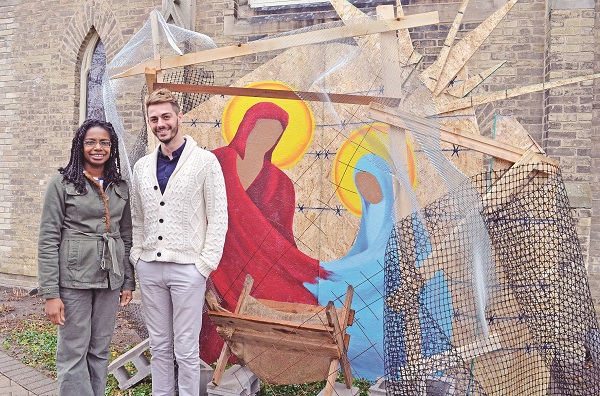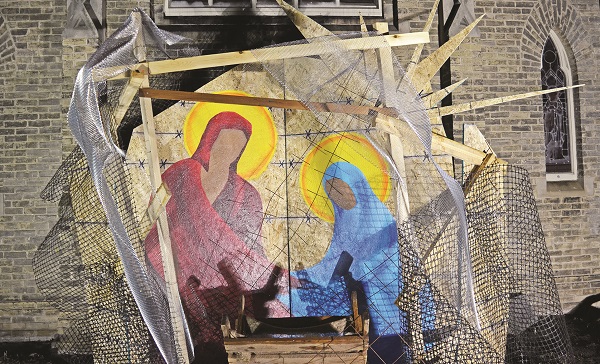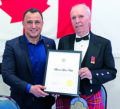Archive » General News » News
Christmas story goes back to basics with a “shock factor”
December 21, 2015 · 0 Comments

By Brock Weir
There’s nothing like a bit of shock value to get people to sit up and take notice.
A good shock could be the thing to get a person out of their comfort zone and take a look at the familiar in a new light or from a different perspective. And when you’ve got some nice, “subversive”, source material to work with, why not start with something at the very heart of Christian values, particularly around the Christmas season?
Over the next few days, take a stroll past Trinity Anglican Church on Victoria Street and take a good look at their nativity scene. Do you see a traditional crèche, or do you see something more? Is it your everyday representation of Mary, Joseph and Jesus, or is there something missing? If there is, what is it?
If you’ve already done so, and any of these questions crossed your mind, then the efforts of Associate Minister Philip Hamilton and artist (and Trinity Parishioner) Roxana Farrell have already paid off.
“We were going for shock value,” says Mr. Hamilton, 28, who joined the Trinity community in August. “So often when you can go to Walmart and just pick up these little Christmas balls with Nativity sets and snowflakes all over them, I think we have domesticated a story that is, at its core, subversive and challenges systems of empire and consumerism. Yet, so often they have been co-opted and used to sell crap. Our hope is that we could show this is still a subversive story, even 2,000 years later. It is the story of welcoming refugees where there is no room. I think it is still a powerful story and it speaks for itself.”
Their efforts, he says, are not intended to reflect specifically on the situation in Syria but the plight of millions around the world wa
iting for asylum. They didn’t want to be “too on the nose”, he says, but at the end of the day, they are working with a story centred on a refugee family.
“The beginning of Christ’s journey into the world is that of having to leave one’s own country and having to find refuge somewhere else, not being accepted in his homeland, and having to sort of fight for their own freedom,” says Ms. Farrell. “This crèche reflects that journey, that uncertainty.”
Perhaps this new take on the traditional Nativity was meant to be. As Trinity began planning for the Christmas season, they found their mainstay crèche was somehow misplaced. Knowing Ms. Farrell’s background as an artist and architect, Mr. Hamilton approached her for a creative partnership based on doing something just a little bit different.
“I was batting around the idea of making more of a political statement with it rather than just putting out a typical Baby Jesus with two figures,” he says.
Responding to questions on the brainstorming process on how they settled on this political statement, both laugh, with an “Oh, Lord!” cutting through the Minister’s chuckle.
Indeed.
“Philip always had the idea of barbed wire, so that is one thing we kept,” says Ms. Farrell. “Everything just evolved and the materials were key to the project, not having to have refined materials, keeping it rough, reflecting what the refugees have now. We wanted raw materials to create the sun of Christ. The brightness of Christ still comes through these rough conditions and these rough materials.”
Adds Mr. Hamilton: “It was kind of fun in a chaotic kind of way.”
The crèche went up in phases, and the duo found that perception from parishioners and passers-by alike varied depending on which stage in the artistic journey they happened to be at the time. The first phase was probably the “prettiest”, concedes Ms. Farrell, as everything was nicely painted, the boards were cut just so, but then it was time to add the nitty and the very gritty with representations of barbed wire, and the star above the manger that is quite open to interpretation. Along the way, a woman stopped Ms. Farrell and asked if she was still working on it. When the artist explained the project further, she says there was a click in the viewer that the “incompleteness” was part of the art.
“A lot of times you can’t present it to the congregation first because what the vision is is very hard to describe in words,” she says. “But, once they see it up, they can have comments and a relationship with it, ask questions, and go, ‘aha!’ If you went to the congregation and said, ‘We’re going to put this up,’ there would instantly be objection, I think. Once it is up, then it is something we can interact with and have a discussion.”
Adds Mr. Hamilton: “It is something that jars people out of that sense of comfort and a version of the story where of babies, no crying did they make, silent night, and things are just peaceful and lovely. I don’t think Christmas is like that. I do think a big part of why Roxana was important for this is the arts have a way of engaging people and good art has a way of engaging people that you can’t with words. It makes you feel something, hopefully. Even not liking it is as important as if you do.
“I am a storyteller and I just like to see people get really passionate about the narrative that can change their lives and their own narrative that can change other people’s lives. I am all about getting people to tell their own stories, to be authentic, and I think it is through authenticity that we change the world and we see real progress, politically, spiritually.”












